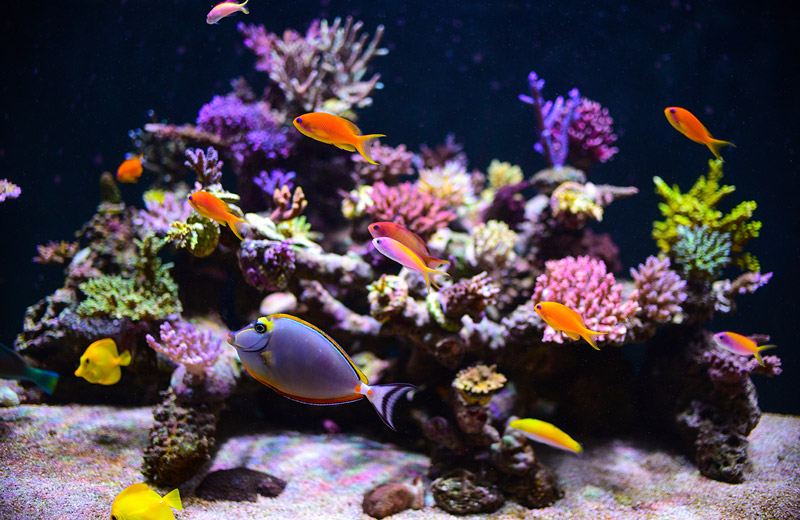A saltwater aquarium is a beautiful and rewarding addition to any home, but maintaining its cleanliness requires regular care. Unlike freshwater tanks, saltwater aquariums need specific cleaning techniques to ensure a stable environment for your fish and corals. This guide will cover the best practices for cleaning a saltwater aquarium while preserving water quality and protecting marine life.
Why Regular Cleaning is Essential for a Saltwater Aquarium
A clean saltwater aquarium promotes healthier fish, vibrant corals, and balanced water chemistry. Here’s why regular maintenance is crucial:
Prevents Algae Growth – Excess nutrients lead to algae outbreaks, clouding your tank.
Maintains Water Quality – Removes toxins like ammonia, nitrites, and nitrates.
Prevents Disease – A clean environment reduces the risk of infections and parasites.
Keeps Equipment Functioning – Salt buildup can damage filters, heaters, and pumps.
📌 Related: How to Cycle Your Betta Tank: A Complete Guide

Best Practices for Cleaning a Saltwater Aquarium
1. Perform Regular Water Changes
Frequency: Change 10-20% of the water every two weeks.
Why? This removes excess nutrients, replenishes trace elements, and stabilizes salinity levels.
How? Use pre-mixed saltwater with the correct salinity and temperature before adding it to your tank.
2. Clean the Glass and Acrylic Walls
Tools Needed: Magnetic algae scrapers, sponges, or soft cloths.
Why? Prevents algae buildup that can obstruct your view and affect light penetration.
Caution: Avoid using household cleaners, as chemicals can be toxic to fish.
📌 Related: Aquarium Glass Cleaning Without Harming Your Fish
3. Maintain the Substrate (Sand or Gravel)
How Often? Once a month, use a siphon to remove detritus and leftover food from the sand bed.
Why? Prevents waste accumulation that can lead to poor water quality and toxic conditions.
Tip: Stirring up the sand too much can release harmful gases trapped in the substrate.
4. Clean the Filtration System
Frequency: Rinse mechanical filter media (sponges, floss) every two weeks. Replace carbon and other chemical media monthly.
Why? Clogged filters reduce efficiency, leading to poor water circulation and increased toxins.
Tip: Never rinse biological filter media in tap water—it kills beneficial bacteria. Use tank water instead.
📌 Related: Aquarium Heater: The Best Way to Clean and Maintain
5. Remove Salt Creep
What is Salt Creep? When water evaporates, salt deposits form on tank edges and equipment.
How to Clean: Use a damp cloth to wipe down salt deposits regularly.
Why? Prevents damage to electrical components and keeps the tank looking neat.
6. Test Water Parameters Regularly
What to Test? Salinity, ammonia, nitrite, nitrate, pH, alkalinity, calcium, and magnesium.
How Often? Weekly testing ensures stable conditions for fish and corals.
Tip: Use a reliable test kit to monitor fluctuations before they become a problem.
📌 Related: The Importance of Regular Water Testing
7. Maintain Proper Water Flow
Why? Water movement prevents debris from settling and promotes gas exchange.
How? Regularly clean powerheads and wave makers to ensure proper circulation.
Tip: Adjust flow patterns to prevent dead spots where waste can accumulate.

Final Tips for Keeping Your Saltwater Aquarium Clean
Consistency is key – Stick to a regular cleaning schedule.
Don’t overfeed – Excess food leads to waste buildup and poor water quality.
Invest in a cleanup crew – Snails, hermit crabs, and shrimp help control algae and waste.
Quarantine new additions – Prevents introducing pests or diseases into your tank.
Final Thoughts
Maintaining a clean saltwater aquarium requires dedication, but following these best cleaning practices will keep your tank thriving. A well-maintained aquarium supports healthier fish, vibrant corals, and crystal-clear water. Stick to a routine, test your water regularly, and enjoy the beauty of your marine ecosystem!
FAQs
1. How often should I clean my saltwater aquarium?
You should perform partial water changes every two weeks, clean the filter media monthly, and test water parameters weekly.
2. Can I use tap water for my saltwater aquarium?
No, tap water contains chlorine, chloramine, and heavy metals. Use RO/DI (Reverse Osmosis Deionized) water to mix with salt for the best water quality.
3. How do I remove algae without harming corals?
Use a magnetic algae scraper or soft brush. If algae overgrowth is an issue, check for excess nutrients and adjust lighting.
4. What is the best way to prevent cloudy water?
Cloudy water is often caused by overfeeding, poor filtration, or bacterial blooms. Maintain regular cleaning, use a protein skimmer, and monitor feeding habits.
5. Why does my aquarium have a bad smell?
A strong odor is a sign of poor water quality. Perform a water change, check filtration, and remove any dead organisms or decaying material.